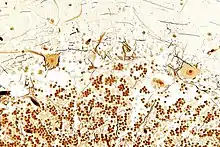Bielschowsky stain
The Bielschowsky technique is a silver staining method used in histochemistry for the visualization of nerve fibers,[1] including multipolar interneurons in the cerebellum.[2]

Bielschowsky silver stain showing the processes of basket cells in the cerebellum.
The method is attributed to German neurologist and neurohistologist Max Bielschowsky (1869–1940),[3][4][5] who made improvements over the previous method developed by Ramon y Cajal (1852–1934).[6]
See also
- Immunohistochemistry
- Luxol fast blue stain
- Neurofilament
References
- Susan Standring (2008-01-01). Gray's Anatomy: The Anatomical Basis of Clinical Practice, Expert Consult - 40th Edition.
- Erickson-Davis CR, Faust PL, Vonsattel JP, et al. (March 2010). ""Hairy baskets" associated with degenerative Purkinje cell changes in essential tremor". J. Neuropathol. Exp. Neurol. 69 (3): 262–71. doi:10.1097/NEN.0b013e3181d1ad04. PMC 2865233. PMID 20142764.
- Stahnisch, F. W. (2014-10-28). "Max Bielschowsky (1869–1940)". Journal of Neurology. 262 (3): 792–794. doi:10.1007/s00415-014-7544-z. ISSN 0340-5354. PMC 4363476. PMID 25346063.
- Gray's Anatomy- The Anatomical Basis of Clinical Practice, Expert Consult- 40th Edition.
- Stahnisch, F. W. (2014). "Pioneers in Neurology". Journal of Neurology. 262 (3): 792–794. doi:10.1007/s00415-014-7544-z. PMC 4363476. PMID 25346063.
- Enersen, Ole Daniel. "Max Bielschowsky". Who Named It. Retrieved 2009-05-31.
This article is issued from Wikipedia. The text is licensed under Creative Commons - Attribution - Sharealike. Additional terms may apply for the media files.